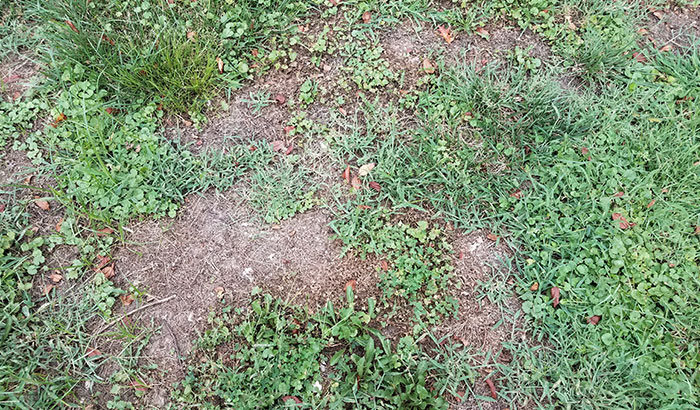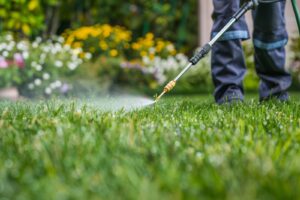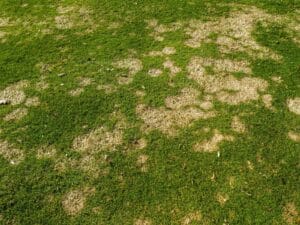Keeping your yard looking pristine can feel like a full-time job, especially when lawn diseases rear their ugly head, but we’re here to help.
When disease attacks your yard, control might be confusing until you know how to identify the disease and the causes and prevention behind it. Is it a summer patch or a brown patch? Is it fungal-based or simply the result of a neighborly dog? Luckily, your lawn can remain disease-free with a little TLC.
Keep reading to learn more about how to tackle eight of the most common lawn diseases and how you can prevent them from overtaking your turf.
- Summer Patch
As its name implies, summer patch is a common lawn disease that shows up during the summer months. This disease manifests as brown or yellow patches that can turn your beautiful green lawn into a yellow blotchy mess.
Summer patch affects the roots, stems, and crowns of the grass. Heat, compacted soil, poor soil drainage, and over-mowing are all factors that can cause this noxious fungus. Try a systemic fungicide if you notice a summer patch claiming its territory. These products are designed to treat your grass and restore it to its beautiful, green self.
- Brown Patch
Brown patch is another common fungal disease that can attack your lawn. The leading cause of this disease is high heat. Brown patch is not partial to any specific yard– it affects every type of lawn and turf out there. If it’s hot outside, your lawn could be at risk.
It’s not difficult to spot a brown patch; you’ll notice a brown area that can grow up to five feet in size. Keep your eye out for the beginnings of a brown patch in the hot months. Beware that over-watering and over-fertilizing can help it spread. Like summer patches, a fungicide can help you eliminate this pesky disease.
- Pythium Blight
Pythium blight typically appears as greasy orange spots, but in some cases, you might notice small fluff balls appearing on your lawn. This disease thrives in humidity. Damp weather encourages it to spread and can even turn the fluff balls into a web-like substance.
Pythium blight is treated with fungicide, specifically one containing mefenoxam. While fungicides can treat the problem, it is ideal to use them for preventative purposes. For best results, always follow the directions on the product label.
- Fairy Ring
A fairy ring might sound magical, but the novelty of its name quickly wears off once it plagues your yard. The fairy ring begins as a dark green shade with a circle of dead grass around it. Seeing mushrooms or white puffs growing in your yard can indicate that the fairy ring has taken hold of your lawn.
To help combat this lawn disease, use a garden fork to puncture holes around the ring, then water the area. This will drown the disease and help push it out of your yard.
- Rust Disease
Rust disease shows up near the beginning of fall when temperatures start to dip and days are shorter. This disease causes yellow flakes to form on the blades of grass. It can live in green and brown grass, so getting rid of the disease is essential before it infects your entire lawn.
Rust disease doesn’t require any special treatment; keep watering and fertilizing your lawn as usual, and it should clear up on its own. If you don’t see any improvement in about 21 days, apply a fungicide designed to target the disease.
- Powdery Mildew
Powdery mildew loves warm weather, and it can affect all types of plants. This disease is also relatively easy to spot as it appears as white powder all over your lawn.
Although rarely fatal, powdery mildew can deprive your lawn and plants of vital nutrients if left unchecked. Fungicide prevention is the best method, but many home remedies can treat an existing infection.
- Red Thread
The red thread shows up as small red patches around four inches long. This disease prefers temperatures between 40 and 80 degrees and commonly grows under water-drenched leaves.
If it’s fall time and many leaves cover your lawn, rake them up quickly. A rainstorm over a pile of leaves creates the perfect habitat for red thread to grow. This lawn disease is not known to kill your lawn outright, but it can weaken it, making it more susceptible to other diseases and insects.
- Snow Mold
There are two types of snow mold– pink and gray.
Pink snow mold is a lawn disease with pink-colored spots that rapidly destroy the grass. This can be difficult to find because the pink color only lasts for a short time.
Despite its name, pink snow mold doesn’t need snow to grow. If you live in a cool and humid climate, this could infect your lawn year-round. Fungicides can treat the disease, but like most lawn diseases, prevention is best. Buy a fungicide and apply it regularly as directed on the bottle to keep pink snow mold at bay.
Gray snow mold can sometimes look similar to pink snow mold. Gray spots will show up on your lawn after prolonged exposure to snow. These spots usually start around eight inches wide but can grow up to several feet in diameter.
Gray snow mold can take a stronghold of your lawn if the snowfall lasts for three months or longer. Fortunately, exterminating gray snow mold is quite easy. This disease can only spread in temperatures 45 degrees or colder, so the snow mold will vanish as it warms up.
Let Summit Lawn & Pest Control Help You Rid of Lawn Disease
Lawn disease is no joke. If you need assistance with any of these pesky diseases, the experts at Summit Lawn & Pest Control are here to help! Our mission is to provide our clients with excellent service with affordable rates.
Contact Summit Lawn & Pest Control today to schedule your free assessment! We serve Lehi, American Fork, Provo, Springville, Spanish Fork, and the surrounding cities in Utah County, Utah.







